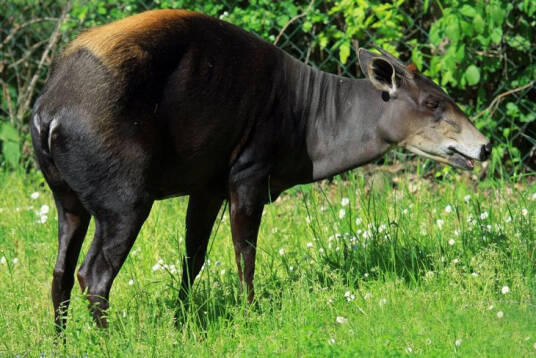Cephalophus silvicultor
IUCN
LCBasic Information
Scientific classification
- name:Cephalophus silvicultor
- Scientific Name:Cephalophus silvicultor,Yellow-backed antelope,
- Outline:Ungulata
- Family:Artiodactylus Bovidae Gazella
Vital signs
- length:115-145cm
- Weight:45-80kg
- lifetime:About 12 years
Feature
One of the largest forest duiker species
Distribution and Habitat
Angola, Benin, Burkina Faso, Burundi, Cameroon, Central African Republic, Democratic Republic of the Congo, Republic of the Congo, Cote d'Ivoire, Equatorial Guinea, Gabon, Ghana, Guinea, Guinea-Bissau, Kenya, Liberia, Nigeria, Senegal, Sierra Leone, South Sudan, Togo, Uganda and Zambia.
Possibly extinct: Rwanda; extinct: Gambia; presence uncertain: Chad.
Throughout most of its range, the yellow-backed duiker occurs in moist lowland and montane forests, including primary and secondary forests, forest-savanna patches, gallery forests, scrubland, and isolated forest patches within moist savanna woodlands; also found in plantations and farm scrub; in montane areas, they occupy bamboo thickets and steep wooded slopes. Recorded in the miombo woodland of Angola. In captivity, the yellow-backed duiker cannot tolerate cold temperatures. They cannot be exposed to a climate of 7 degrees Celsius for a long time, but can withstand temperatures of 43 degrees Celsius.
Appearance
The yellow-backed duiker is one of the largest forest duiker species, weighing 45-80 kg in the wild, with a body length of 115-145 cm and a tail length of 11-18 cm. Relative to body size, the yellow-backed duiker has a larger brain size than any other antelope species. The fur color of this species is black or brown, with a yellow triangular patch near the tail. This yellow patch usually does not appear until about 1 month of age and is not fully developed until about 10 months of age. Males and females are similar to each other in appearance, although females are slightly larger. The muzzle area surrounding the white lips is light gray. Both sexes have short, tapered horns that are between 8.5-21 cm in length. Young yellow-backed duikers are dark brown at birth, with spots on their sides and a red belly. These mysterious colors help them hide from predators in the forest.
The yellow-backed duiker has unique scent glands behind each eye. Unlike other antelope species, these glands s
Details
Yellow-backed Duiker (scientific name: Cephalophus silvicultor) English: Yellow-backed Duiker, French: Céphalophe géant, Céphalophe à dos jaune, Spanish: Duiquero de Lomo Amarillo, German: Gelbrückenducker, Riesenducker, there are 4 subspecies.

The yellow-backed duiker is an unsociable species. They rest alone during the day as "singles" - often resting under fallen trees, in dense brush or clumps of exposed tree roots - and forage at night. Males and females share territories and loosely bond to mate. Yellow-backed duikers have also been observed resting on the crests of termite mounds to gain vantage points. This, and the fact that some females have been observed with broken horns, suggests that this species aggressively defends territories, and that territorial boundaries are also marked with maxillary glands.
Yellow-backed duikers communicate using unique scent glands in front of their eyes. These maxillary glands are composed of connective tissue surrounded by 2 to 3 secretory layers that form hairless slits. The presence of these glands causes the cheeks to swell. The duikers also have scent glands behind each hoof. Glandular scent is used to communicate territorial boundaries, reproductive status, and as a way to solidify social bonds. Yellow-backed duikers also communicate through grunts and piercing calls. When frightened, these duikers emit a piercing whistle, raise their backs and flee.
Yellow-backed duikers are selective foraging frugivores. The typical diet is low in fiber. Starches ferment quickly and pass through the digestive tract quickly. In addition to fruit, they eat leaves, seeds, bark, and buds. In the wild, four yellow-backed duikers were tested and found to consume 71.3% of fruit matter and 28.6% of dry weight. Occasionally, these forest antelopes will kill and eat small animals such as birds. Of the 28.6% dry weight, 0.1% is animal matter. The species specializes in eating fruit that has fallen from trees and can eat fruit or seeds that are too large or hard for primates and other frugivores to eat. The cheek teeth of the duikers are specialized for chewing tough bark and roots. The long, pointed tongue and movable lips make leaves easy to obtain and manipulate. They use their hooves and snouts to dig for food in the ground. The large size of the yellow-backed duikers forces them to forage almost constantly.
Mating pairs of yellow-backed duikers lick each other socially. This behavior also occurs between mothers and calves. Adult duikers rub their preorbital scent glands on the bodies and legs of other adults. Duiker mates also press these scent glands together as a possible sign of pair bonding. Females are thought to defend the territory they share with males. However, pair duty can be quite short-lived. In captivity, yellow-backed duikers come into estrus once a month year-round for 2-3 days. The gestation period is approximately 7 months, after which females give birth to a single calf. Occasionally, 2 are born. Females can breed twice a year. Young yellow-backed duikers hide in the forest for 1-2 weeks. A captive male yellow-backed duiker at the Los Angeles Zoo was weaned after 95 days, although other yellow-backed duikers have been recorded at around 5 months. Females reach sexual maturity at 9-12 months of age, while males reach sexual maturity at 12-18 months.
In 1999, densities of 0.1-1.0 individuals per square kilometer were measured throughout the area, which resulted in a population estimate of approximately 160,000 individuals. Densities recorded in 2013 ranged from 0.9-2.1 individuals per square kilometer. The species' population trend is generally declining, except in some areas where hunting pressure is low due to scarcity and/or effective prevention of poaching.
Listed in the IUCN Red List of Threatened Species in 2016 ver3.1 - Near Threatened (NT).
Listed in Appendix I, Appendix II and Appendix III of the Convention on International Trade in Endangered Species of Wild Fauna and Flora (CITES) 2019 Edition.
Protect wild animals and eliminate game.
Maintaining ecological balance is everyone's responsibility!








